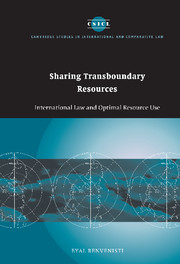Book contents
- Frontmatter
- Contents
- Acknowledgments
- Table of cases
- List of abbreviations
- 1 Introduction
- 2 The need for collective action in the management of transboundary resources
- 3 States as collective actors
- 4 The transnational conflict paradigm: structural failures and responses
- 5 Transnational institutions for transboundary ecosystem management: defining the tasks and the constraints
- 6 The structure and procedure of institutions for transboundary ecosystem management
- 7 The development of positive international law on transboundary ecosystems: a critical analysis
- 8 Efficiency, custom, and the evolution of international law on transboundary resources
- 9 Conclusion
- Bibliograhy
- Index
- CAMBRIDGE STUDIES IN INTERNATIONAL AND COMPARATIVE LAW
6 - The structure and procedure of institutions for transboundary ecosystem management
Published online by Cambridge University Press: 14 July 2009
- Frontmatter
- Contents
- Acknowledgments
- Table of cases
- List of abbreviations
- 1 Introduction
- 2 The need for collective action in the management of transboundary resources
- 3 States as collective actors
- 4 The transnational conflict paradigm: structural failures and responses
- 5 Transnational institutions for transboundary ecosystem management: defining the tasks and the constraints
- 6 The structure and procedure of institutions for transboundary ecosystem management
- 7 The development of positive international law on transboundary ecosystems: a critical analysis
- 8 Efficiency, custom, and the evolution of international law on transboundary resources
- 9 Conclusion
- Bibliograhy
- Index
- CAMBRIDGE STUDIES IN INTERNATIONAL AND COMPARATIVE LAW
Summary
Introduction
This chapter discusses the different characteristics of the transnational institutions for ecosystem management required for responding to the challenges identified in the previous chapter. Shared management of transnational resources requires sensitivity to the interaction between the shared institution and the participating national governments. A carefully planned system of checks and balances must be created to prevent ineffective joint management, on the one hand, and inattention to national concerns, on the other. States will agree to confer sovereign authority to the joint institution only if they are allowed to retain important tools – such as veto power over decisions, control of the institution's budget, sufficient representation in the institution's bureaucracy, and judicial review over the institution's decision – to ensure them reasonable control over the institution's decision-making processes.
In light of these requirements, the first part of this chapter discusses the structure of transnational ecosystem institutions, addressing such issues as subsidiarity, the relationship between the transnational and the national processes, and the relationships between different institutions with overlapping competences. Emphasis is placed on the possibilities for reducing the likelihood of skewed or uninformed decisions.
The second part examines the decision-making processes within transnational institutions, focusing on the effort to provide flexibility and mutuality in a transparent process that ensures voice to the interested public.
The structure of transnational ecosystem institutions
This part addresses the relationship between the national and the transnational levels.
Information
- Type
- Chapter
- Information
- Sharing Transboundary ResourcesInternational Law and Optimal Resource Use, pp. 131 - 155Publisher: Cambridge University PressPrint publication year: 2002
